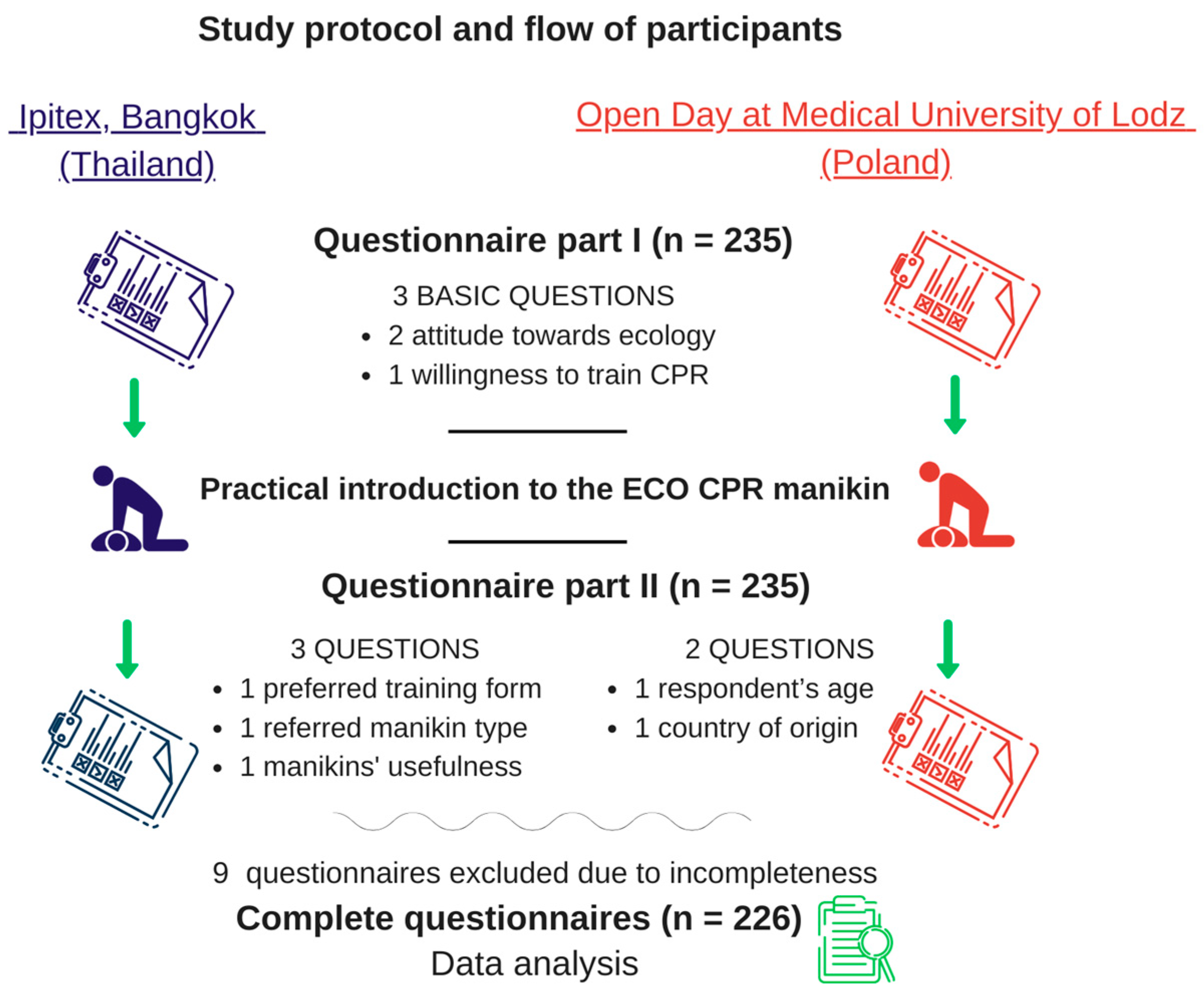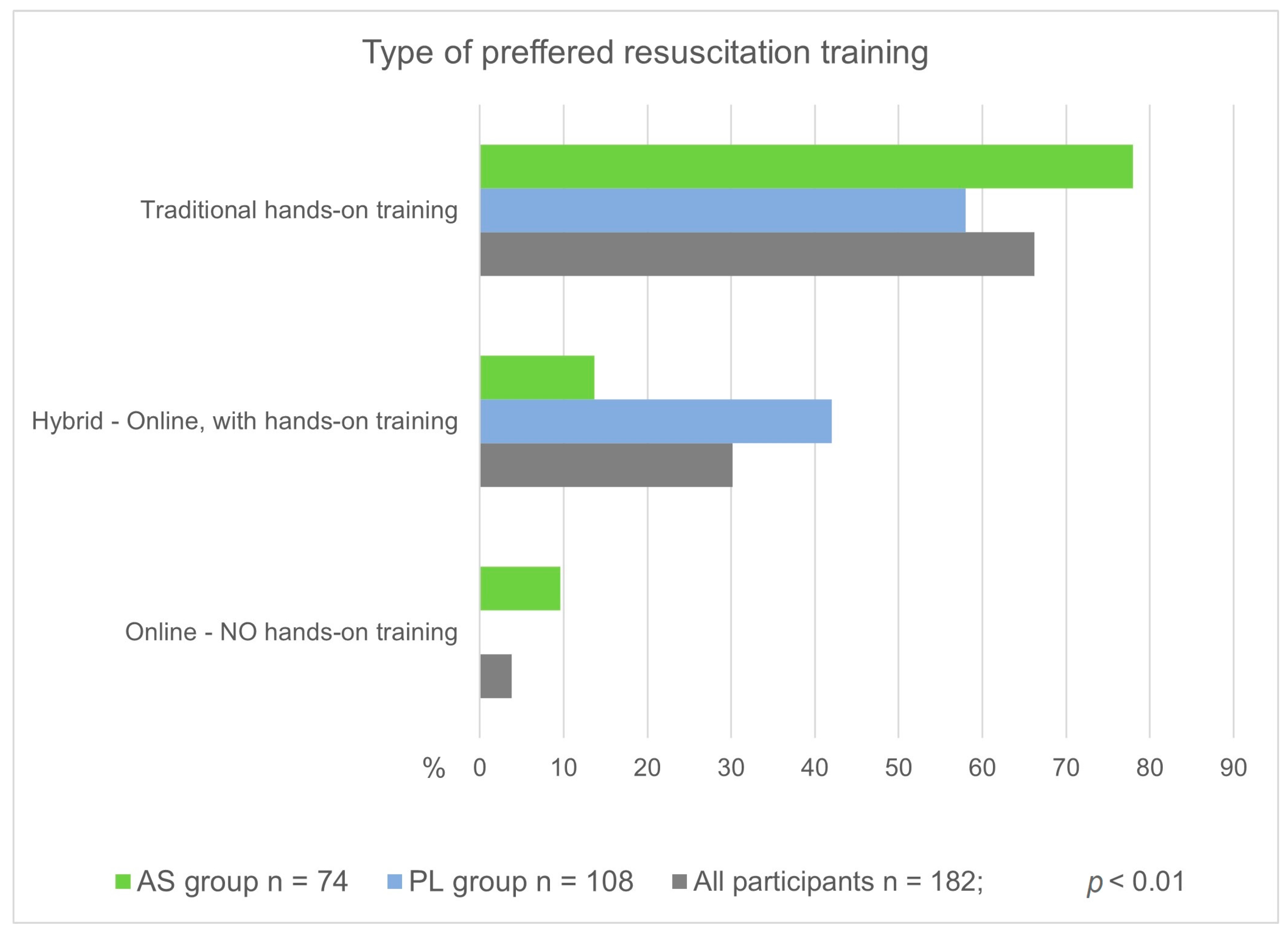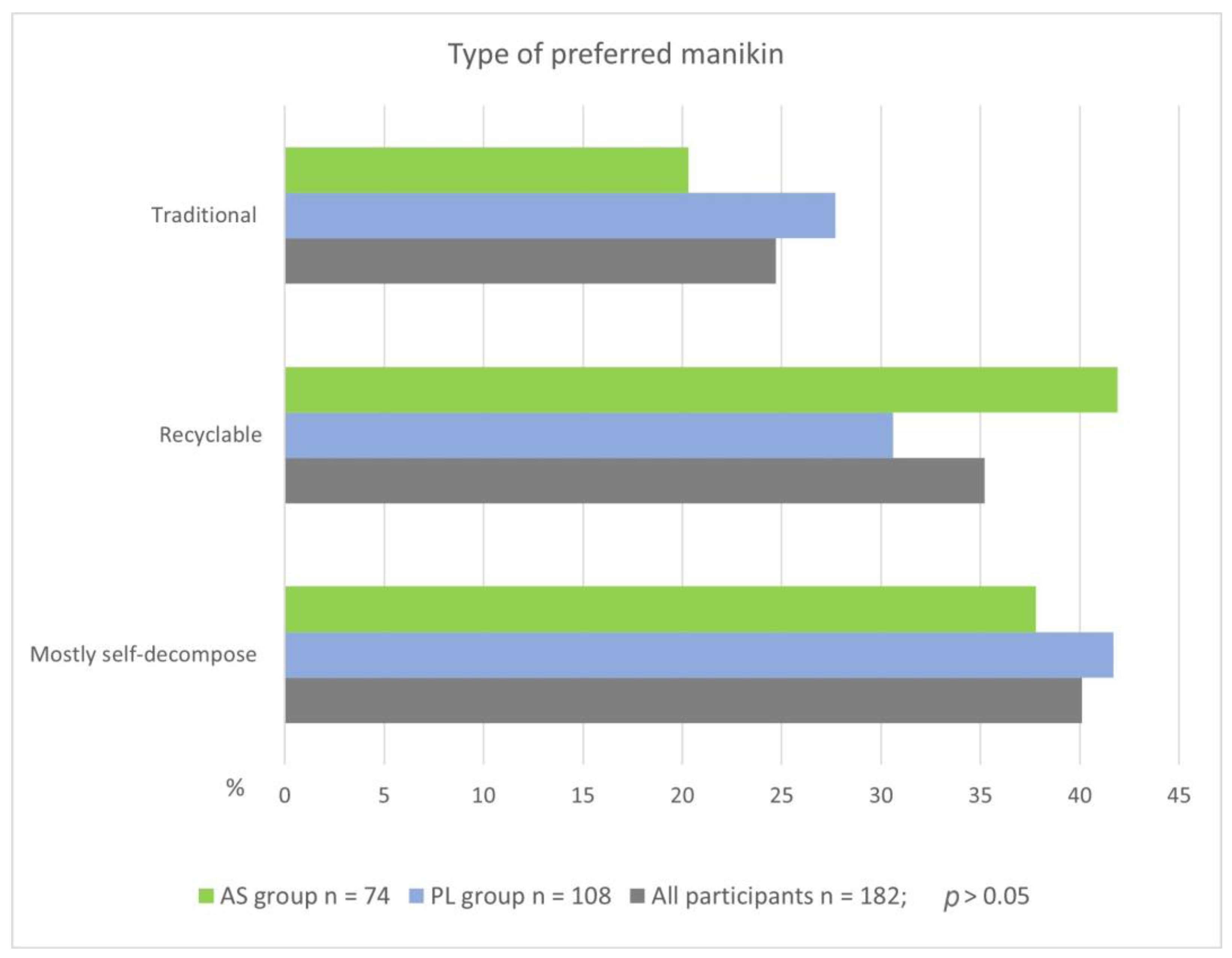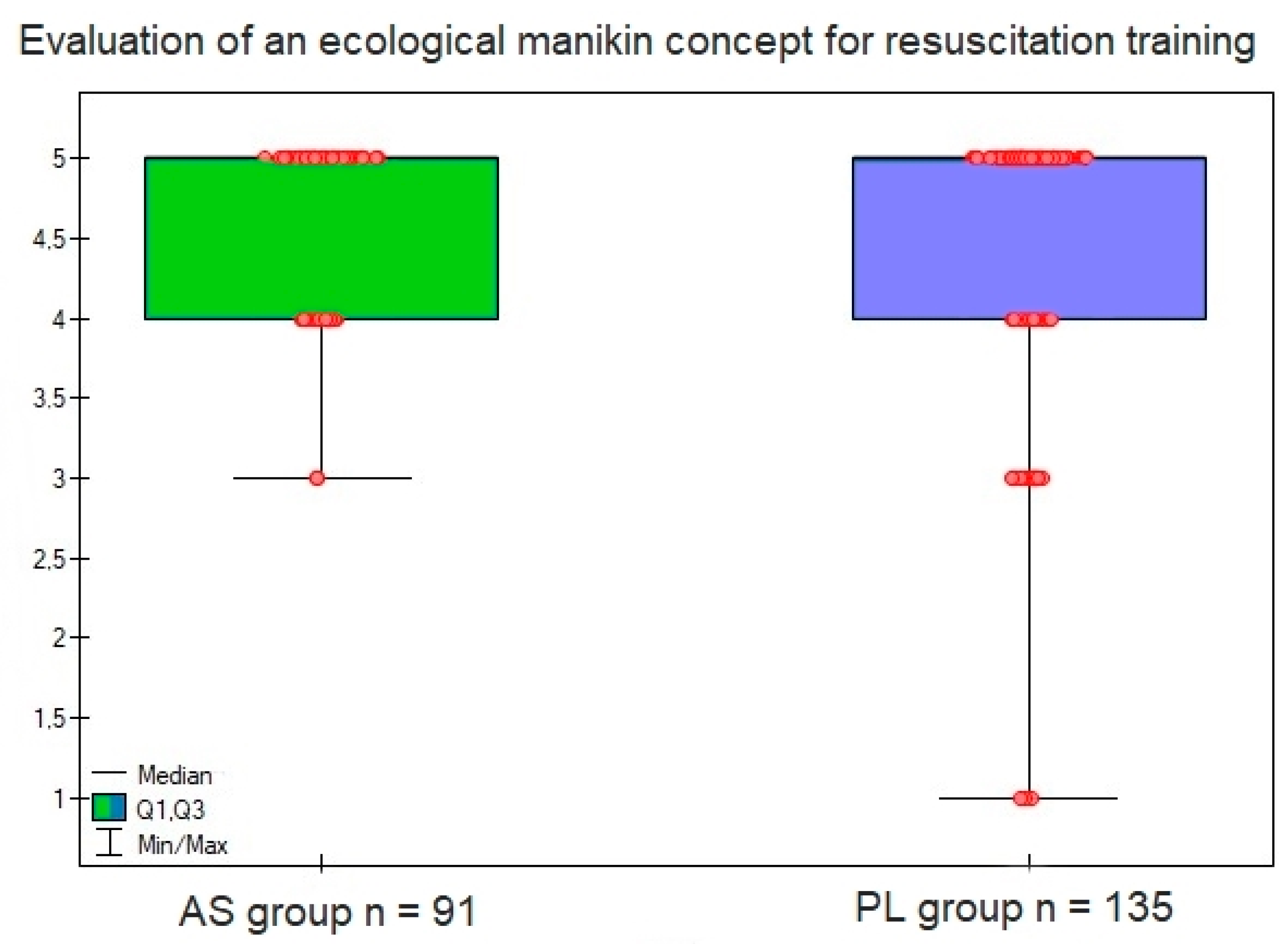Attitudes of Asian and Polish Adolescents towards the Use of Ecological Innovations in CPR Training
Abstract
:1. Introduction
2. Aims
- preferred form of CPR training;
- preferred manikin in terms of materials used for its construction;
- respondents’ attitudes to a manikin made of ecological materials and its usefulness in mass CPR training.
3. Materials and Methods
3.1. Study Setting
3.2. Participants
3.3. Data Sources/Measurement
- It is comprehensible for respondents;
- It is interpretated in the same way by all the respondents;
- Any aspect of the questionnaire suggests researcher’s bias.
3.4. Statistical Analysis
4. Results
5. Discussion
6. Limitations
7. Conclusions
Supplementary Materials
Author Contributions
Funding
Institutional Review Board Statement
Informed Consent Statement
Data Availability Statement
Acknowledgments
Conflicts of Interest
References
- Gräsner, J.-T.; Herlitz, J.; Tjelmeland, I.B.; Wnent, J.; Masterson, S.; Lilja, G.; Bein, B.; Böttiger, B.W.; Rosell-Ortiz, F.; Nolan, J.P.; et al. European Resuscitation Council Guidelines 2021: Epidemiology of cardiac arrest in Europe. Resuscitation 2021, 161, 61–79. [Google Scholar] [CrossRef] [PubMed]
- Kiguchi, T.; Okubo, M.; Nishiyama, C.; Maconochie, I.; Ong, M.E.H.; Kern, K.B.; Wyckoff, M.H.; McNally, B.; Christensen, E.F.; Tjelmeland, I.; et al. Out-of-hospital cardiac arrest worldwide: First report of the International Liaison Committee on Resuscitation (ILCOR). Resuscitation 2020, 152, 39–49. [Google Scholar] [CrossRef] [PubMed]
- Ko, J.S.; Kim, S.R.; Cho, B.J. The Effect of Cardiopulmonary Resuscitation (CPR) Education on the CPR Knowledge, Attitudes, Self-Efficacy, and Confidence in Performing CPR among Elementary School Students in Korea. Healthcare 2023, 11, 2047. [Google Scholar] [CrossRef]
- Chen, M.; Wang, Y.; Li, X.; Hou, L.; Wang, Y.; Liu, J.; Han, F. Public knowledge and attitudes towards bystander cardiopulmonary resuscitation in China. Biomed Res. Int. 2017, 2017, 3250485. [Google Scholar] [CrossRef]
- Bouland, A.J.; Halliday, M.H.; Comer, A.C.; Levy, M.J.; Seaman, K.G.; Lawner, B.J. Assessment of barriers to cardiopulmonary resuscitation among non-medical personnel before and after cardiopulmonary resuscitation training. Prehospital Emerg. Care 2017, 21, 662–669. [Google Scholar] [CrossRef]
- Abelsson, A.; Odestrand, P.; Nygårdh, A. Strengthening self-confidence as a step in improving basic prehospital emergency activities in adolescents. BMC Emerg. Med. 2020, 20, 8. [Google Scholar] [CrossRef]
- Nakagawa, N.K.; Salles, I.C.; Semeraro, F.; Böttiger, B.W. KIDS SAVE LIVES: A narrative review of associated scientific production. Curr. Opin. Crit. Care 2021, 27, 623–636. [Google Scholar] [CrossRef]
- González-Salvado, V.; Rodríguez-Ruiz, E.; Abelairas-Gómez, C.; Ruano-Raviña, A.; Peña-Gil, C.; González-Juanatey, J.R.; Rodriguez-Nunez, A. Training adult laypeople in basic resuscitation procedures. A systematic review. Rev. Esp. Cardiol. 2020, 73, 53–68. [Google Scholar] [CrossRef]
- Panchal, A.R.; Bartos, J.A.; Cabañas, J.G.; Donnino, M.W.; Drennan, I.R.; Hirsch, K.G.; Kudenchuk, P.J.; Kurz, M.C.; Lavonas, E.J.; Morley, P.T.; et al. Adult Basic and Advanced Life Support Writing Group. Part 3: Basic and advanced resuscitation in adults: 2020 American Heart Association Guidelines for Cardiopulmonary Resuscitation and Emergency Cardiovascular Care. Circulation 2020, 142 (Suppl. S2), S366–S468. [Google Scholar] [CrossRef] [PubMed]
- Olasveengen, T.M.; Semeraro, F.; Ristagno, G.; Castren, M.; Handley, A.; Kuzovlev, A.; Monsieurs, K.G.; Raffay, V.; Smyth, M.; Soar, J.; et al. European Resuscitation Council Guidelines 2021: Basic resuscitation procedures. Resuscitation 2021, 161, 98–114. [Google Scholar] [CrossRef]
- Greif, R.; Lockey, A.; Breckwoldt, J.; Carmona, F.; Conaghan, P.; Kuzovlev, A.; Pflanzl-Knizacek, L.; Sari, F.; Shammet, S.; Scapigliati, A.; et al. European Resuscitation Council Guidelines 2021: Education in resuscitation. Resuscitation 2021, 161, 388–407. [Google Scholar] [CrossRef]
- Greif, R.; Lockey, A.; Breckwoldt, J.; Carmona, F.; Conaghan, P.; Kuzovlev, A.; Pflanzl-Knizacek, L.; Sari, F.; Shammet, S.; Scapigliati, A.; et al. Education, implementation and teams: International consensus 2020 on cardiopulmonary resuscitation and cardiovascular emergency science with treatment recommendations. Resuscitation 2020, 156, A188–A239. [Google Scholar] [CrossRef] [PubMed]
- Park, H.J.; Jeong, W.J.; Moon, H.J.; Kim, G.W.; Cho, J.S.; Lee, K.M.; Choi, H.J.; Park, Y.J.; Lee, C.A. Factors associated with high quality observer-performed cardiopulmonary resuscitation. Emerg. Med. Int. 2020, 2020, 8356201. [Google Scholar] [CrossRef]
- Song, J.; Guo, W.; Lu, X.; Kang, X.; Song, Y.; Gong, D. Effect of bystander cardiopulmonary resuscitation on survival of out-of-hospital cardiac arrests: A systematic review and meta-analysis. Scand. J. Trauma Resusc. Emerg. Med. 2018, 26, 86. [Google Scholar] [CrossRef]
- Van Raemdonck, V.; Monsieurs, K.G.; Aerenhouts, D.; De Martelaer, K. Teaching basic life-saving measures: A prospective randomised study of low-cost training strategies in secondary schools. Eur. J. Emerg. Med. 2014, 21, 284–290. [Google Scholar] [CrossRef] [PubMed]
- Lim, X.M.A.; Liao, W.A.; Wang, W.; Seah, B. Effectiveness of technology-based CPR training on adolescent skills and knowledge: A systematic review and meta-analysis. J. Med. Internet Res. 2022, 24, e36423. [Google Scholar] [CrossRef]
- Nishiyama, C.; Sato, R.; Baba, M.; Kuroki, H.; Kawamura, T.; Kiguchi, T.; Kobayashi, D.; Shimamoto, T.; Koike, K.; Tanaka, S.; et al. Actual resuscitation efforts after training in cardiopulmonary resuscitation with chest compression and AED use among new students. Resuscitation 2019, 141, 63–68. [Google Scholar] [CrossRef]
- Scapigliati, A.; Zace, D.; Matsuyama, T.; Pisapia, L.; Saviani, M.; Semeraro, F.; Ristagno, G.; Laurenti, P.; Bray, J.E.; Greif, R.; et al. On Behalf of The International Liaison Committee on Resuscitation Education Implementation and Teams Task Force. Community Initiatives to Promote Basic Life Support Implementation—A Scoping Review. J. Clin. Med. 2021, 10, 5719. [Google Scholar] [CrossRef] [PubMed]
- Bray, J.; Acworth, J.; Page, G.; Parr, M.; Morley, P. Australian Resuscitation Council and KIDS SAVE LIVES stakeholder organisations. Aussie KIDS SAVE LIVES: An Australian Resuscitation Council position statement supported by stakeholders. Emerg. Med. Australas. 2021, 33, 944–946. [Google Scholar] [CrossRef]
- Semeraro, F.; Greif, R.; Böttiger, B.W.; Burkart, R.; Cimpoesu, D.; Georgiou, M.; Yeung, J.; Lippert, F.; Lockey, A.S.; Olasveengen, T.M.; et al. European Resuscitation Council guidelines 2021: Life-saving systems. Resuscitation 2021, 161, 80–97. [Google Scholar] [CrossRef] [PubMed]
- Anuntaseree, S.; Kalkornsurapranee, E.; Yuenyongviwat, V. Efficacy of and Satisfaction with an In-house Developed Natural Rubber Cardiopulmonary Resuscitation Manikin. West J. Emerg. Med. 2019, 21, 91–95. [Google Scholar] [CrossRef]
- Rabanales-Sotos, J.; Guisado-Requena, I.M.; Leiton-Espinoza, Z.E.; Guerrero-Agenjo, C.M.; López-Torres-Hidalgo, J.; Martín-Conty, J.L.; Martín-Rodriguez, F.; López-Tendero, J.; López-González, A. Development and validation of a new ultra-compact and cost-effective device for basic manual CPR training: A Randomized, Sham-Controlled, Blinded Trial. Int. J. Environ. Res. Public Health 2022, 19, 15228. [Google Scholar] [CrossRef] [PubMed]
- Tuomisto, H. The organic burger. EMBO Rep. 2021, 22, e52698. [Google Scholar] [CrossRef]
- Tran, K.; Nguyen, T.; Tran, Y.; Nguyen, A.; Luu, K.; Nguyen, Y. Environmental fashion among generation Z: A mixed-methods study on price value image, customer satisfaction and environmental behaviour. PLoS ONE 2022, 17, e0272789. [Google Scholar] [CrossRef]
- Shah, A. How environmentally friendly are our toothbrushes? Br. Dent. J. 2020, 229, 300–301. [Google Scholar] [CrossRef]
- Huang, Z.; Nazifi, S.; Hakimian, A.; Firuznia, R.; Ghasemi, H. ‘Built to Last’: Durable plant-based antimicrobial coatings. ACS Appl. Mater. Interfaces 2022, 14, 43681–43689. [Google Scholar] [CrossRef]
- Cummins, R.O.; Ornato, J.P.; Thies, W.H.; Pepe, P.E. Improving survival after sudden cardiac arrest: The ‘chain of survival’ concept. A statement for health professionals from the Advanced Cardiac Life Support Subcommittee and the Emergency Cardiac Care Committee, American Heart Association. Circulation 1991, 83, 1832–1847. [Google Scholar] [CrossRef]
- Panchal, A.R.; Fishman, J.; Camp-Rogers, T.; Starodub, R.; Merchant, R.M. An ‘intention-centred’ paradigm for improving bystander CPR performance. Resuscitation 2015, 88, 48–51. [Google Scholar] [CrossRef] [PubMed]
- Mini Anne Material Specifications. Available online: https://laerdal.my.site.com/HelpCenter/s/article/Mini-Anne-material-specifications?r=91&ui-knowledge-components-aura-actions.KnowledgeArticleVersionCreateDraftFromOnlineAction.createDraftFromOnlineArticle=1 (accessed on 16 October 2023).
- PRESTAN Manikins Frequently Asked Questions. Available online: https://www.prestan.com/clientuploads/directory/products/PRESTAN-General-Manikins-FAQs.pdf (accessed on 15 October 2023).
- Yan, S.; Gan, Y.; Wang, R.; Song, X.; Zhou, N.; Lv, C. Willingness to participate in cardiopulmonary resuscitation (CPR) training and associated factors among adults in China. Crit. Care 2020, 24, 457. [Google Scholar] [CrossRef]
- Jiang, Y.; Wu, B.; Long, L.; Li, J.; Jin, X. Attitudes and readiness for out-of-hospital cardiopulmonary resuscitation: A questionnaire survey among online trainees in China. BMJ Open 2020, 10, e038712. [Google Scholar] [CrossRef] [PubMed]
- Pei-Chuan Huang, E.; Chiang, W.C.; Hsieh, M.J.; Wang, H.C.; Yang, C.W.; Lu, T.C.; Wang, C.H.; Chong, K.M.; Lin, C.H.; Kuo, C.W.; et al. Public knowledge, attitudes and preparedness regarding cardiopulmonary resuscitation: A nationwide survey in Taiwan. J. Formos. Med. Assoc. 2019, 118, 572–581. [Google Scholar] [CrossRef]
- Birkun, A.; Kosova, Y. Social attitude and willingness to participate in cardiopulmonary resuscitation training and perform CPR in Crimea. World J. Emerg. Med. 2018, 9, 237–248. [Google Scholar] [CrossRef]
- Andréll, C.; Christensson, C.; Rehn, L.; Friberg, H.; Dankiewicz, J. Knowledge and attitudes towards cardiopulmonary resuscitation (CPR)—A cross-sectional population-based study in Sweden. Resusc. Plus 2021, 5, 100071. [Google Scholar] [CrossRef]
- Luiz, T.; Dittrich, S.; Pollach, G.; Madler, C. Population knowledge about the main symptoms of cardiovascular emergencies and the responsibility and availability of emergency medical facilities: Results from the KZEN study in the Western Palatinate. Anaesthesist 2017, 66, 840–849. [Google Scholar] [CrossRef]
- Bakke, H.K.; Steinvik, T.; Angell, J.; Wisborg, T. A nationwide survey on first aid training and encounters in Norway. BMC Emerg. Med. 2017, 17, 6. [Google Scholar] [CrossRef]
- Lim, S.L.; Toh, C.; Fook-Chong, S.; Yazid, M.; Shahidah, N.; Ng, Q.X.; Ho, A.F.; Arulanandam, S.; Leong, B.S.; White, A.E.; et al. Impact of COVID-19 on barriers to dispatcher-assisted cardiopulmonary resuscitation in adult out-of-hospital cardiac arrests in Singapore. Resuscitation 2022, 181, 40–47. [Google Scholar] [CrossRef]
- Lim, S.L.; Shahidah, N.; Saffari, S.E.; Ng, Q.X.; Ho, A.F.W.; Leong, B.S.; Arulanandam, S.; Siddiqui, F.J.; Ong, M.E.H. Impact of COVID-19 on Out-Of-Hospital Cardiac Arrest in Singapore. Int. J. Environ. Res. Public Health 2021, 18, 3646. [Google Scholar] [CrossRef]
- Rosell Ortiz, F.; Fernández Del Valle, P.; Knox, E.C.; Jiménez Fábrega, X.; Navalpotro Pascual, J.M.; Mateo Rodríguez, I.; Ruiz Azpiazu, J.I.; Iglesias Vázquez, J.A.; Echarri Sucunza, A.; Alonso Moreno, D.F.; et al. Influence of the COVID-19 pandemic on out-of-hospital cardiac arrest. A Spanish nationwide prospective cohort study. Resuscitation 2020, 157, 230–240. [Google Scholar] [CrossRef]
- Grunau, B.; Bal, J.; Scheuermeyer, F.; Guh, D.; Dainty, K.N.; Helmer, J.; Saini, S.; Chakrabarti, A.; Brar, N.; Sidhu, N.; et al. Bystanders are less willing to resuscitate out-of-hospital cardiac arrest victims during the COVID-19 pandemic. Resusc. Plus 2020, 4, 100034. [Google Scholar] [CrossRef]
- Chong, K.M.; Chen, J.W.; Lien, W.C.; Yang, M.F.; Wang, H.C.; Liu, S.S.; Chen, Y.P.; Chi, C.Y.; Wu, M.C.; Wu, C.Y.; et al. Attitude and behavior toward bystander cardiopulmonary resuscitation during COVID-19 outbreak. PLoS ONE 2021, 16, e0252841. [Google Scholar] [CrossRef]
- Tran, Q.N.N.; Moriguchi, T.; Harii, N.; Goto, J.; Harada, D.; Sugawara, H.; Takamino, J.; Ueno, M.; Ise, H.; Watanabe, A.; et al. Efficacy of the Continuous Resuscitation Training with the Gap Period due to the COVID-19 Pandemic. Int. Med. Educ. 2023, 2, 188–197. [Google Scholar] [CrossRef]
- Daud, A.; Nawi, A.M.; Aizuddin, A.N.; Yahya, M.F. Factors and Barriers on Cardiopulmonary Resuscitation and Automated External Defibrillator Willingness to Use among the Community: A 2016-2021 Systematic Review and Data Synthesis. Glob. Heart 2023, 18, 46. [Google Scholar] [CrossRef]
- Gaafar, R.M.; Khan, A.S.; Elmorsy, S. Knowledge and attitudes of the young population towards CPR training, results of the largest training session in an official attempt to enter the Guinness Book of World Records: A cross-sectional study from Saudi Arabia. J. Family Med. Prim Care 2022, 11, 531–536. [Google Scholar] [CrossRef] [PubMed]
- Allan, K.S.; Mammarella, B.; Visanji, M.; Moglica, E.; Sadeghlo, N.; O’Neil, E.; Chan, T.T.; Kishibe, T.; Aves, T. Methods to teach schoolchildren how to perform and retain cardiopulmonary resuscitation (CPR) skills: A systematic review and meta-analysis. Resusc. Plus 2023, 15, 100439. [Google Scholar] [CrossRef] [PubMed]
- Schnaubelt, S.; Garg, R.; Atiq, H.; Baig, N.; Bernardino, M.; Bigham, B.; Dickson, S.; Geduld, H.; Al-Hilali, Z.; Karki, S.; et al. Cardiopulmonary resuscitation in low-resource settings: A statement by the International Liaison Committee on Resuscitation, supported by the AFEM, EUSEM, IFEM, and IFRC. Lancet Glob. Health 2023, 11, e1444–e1453. [Google Scholar] [CrossRef] [PubMed]
- Birkun, A. The do-it-yourself PET bottle manikin: An under-researched way to improve mass cardiopulmonary resuscitation training in a simple and inexpensive way. Afr. J. Emerg. Med. 2021, 11, 309–310. [Google Scholar] [CrossRef]
- Nakagawa, N.K.; Oliveira, K.M.; Lockey, A.; Semeraro, F.; Aikawa, P.; Macchione, M.; Carvalho-Oliveira, R.; Gouvêa, G.B.; Boaventura, A.P.; Maiworm, A.I.; et al. Effectiveness of a 40-min manual manikin program for hands-on teaching of cardiopulmonary resuscitation in school communities. Am. J. Cardiol. 2021, 139, 126–130. [Google Scholar] [CrossRef]
- CANNE—Self-Directed CPR Learning. Available online: https://www.umu.se/en/umea-institute-of-design/education/student-work/masters-programme-in-advanced-product-design/2021/shuai-li/ (accessed on 15 September 2023).






| AS Group N = 91 (%) | EN Group N = 135 (%) | All Participants N = 226 (%) | p-Value | ||||
|---|---|---|---|---|---|---|---|
| Would you like to take part in a CPR training in the future? | YES 74 (81.3) | NO 18 (19.7) | YES 108 (80.0) | NO 28 (20.0) | YES 182 (80.5) | NO 46 (19.5) | >0.05 |
Disclaimer/Publisher’s Note: The statements, opinions and data contained in all publications are solely those of the individual author(s) and contributor(s) and not of MDPI and/or the editor(s). MDPI and/or the editor(s) disclaim responsibility for any injury to people or property resulting from any ideas, methods, instructions or products referred to in the content. |
© 2023 by the authors. Licensee MDPI, Basel, Switzerland. This article is an open access article distributed under the terms and conditions of the Creative Commons Attribution (CC BY) license (https://creativecommons.org/licenses/by/4.0/).
Share and Cite
Jaskiewicz, F.; Timler, D. Attitudes of Asian and Polish Adolescents towards the Use of Ecological Innovations in CPR Training. J. Clin. Med. 2023, 12, 6939. https://doi.org/10.3390/jcm12216939
Jaskiewicz F, Timler D. Attitudes of Asian and Polish Adolescents towards the Use of Ecological Innovations in CPR Training. Journal of Clinical Medicine. 2023; 12(21):6939. https://doi.org/10.3390/jcm12216939
Chicago/Turabian StyleJaskiewicz, Filip, and Dariusz Timler. 2023. "Attitudes of Asian and Polish Adolescents towards the Use of Ecological Innovations in CPR Training" Journal of Clinical Medicine 12, no. 21: 6939. https://doi.org/10.3390/jcm12216939
APA StyleJaskiewicz, F., & Timler, D. (2023). Attitudes of Asian and Polish Adolescents towards the Use of Ecological Innovations in CPR Training. Journal of Clinical Medicine, 12(21), 6939. https://doi.org/10.3390/jcm12216939







